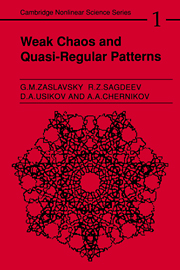Book contents
8 - Two-dimensional hydrodynamic patterns with symmetry and quasi-symmetry
Published online by Cambridge University Press: 29 October 2009
Summary
We have shown that the phase portrait of a dynamic system with 1½ degrees of freedom can have a certain not-too-complex periodical or almost periodical structure. Such properties of the system's phase plane require quite definite conditions, which imply the existence of a stochasticity region (a stochastic web). It was this web that caused a partitioning of the phase plane either with a periodic symmetry (or simply symmetry) or with a quasi-periodic symmetry (or quasi-symmetry). This led us to a new concept of symmetries produced by dynamic systems in phase space. To what extent are symmetries of partitioning of phase space universal and are similar symmetries found in other natural objects?
We have already mentioned quasi-crystals as an example of quasi-symmetrical patterns. In this chapter we are going to show that hydrodynamic flows can also possess symmetry and quasi-symmetry similar to those displayed by the dynamic systems discussed earlier.
The formation of symmetry patterns in liquids has been known for a long time. An example of one of the simplest patterns (from the geometrical point of view) is Von Karman's vortex street. It consists of two rows of evenly spaced point vortexes arranged as on a chess board. The model of the vortex street was proposed by Von Karman to explain periodic traces behind a streamline cylinder for Reynolds numbers 30 < Re < 300. Von Karman's street is an example of a one-dimensional periodic chain, and this structural property is widely used in the analysis of its characteristics.
Among two-dimensional periodic patterns, the most famous is Benard's convective cell. This cell is formed as a result of thermal convection (the so-called Rayleigh–Benard convection).
Information
- Type
- Chapter
- Information
- Weak Chaos and Quasi-Regular Patterns , pp. 170 - 187Publisher: Cambridge University PressPrint publication year: 1991
